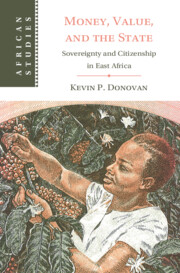96 results
1 - Institutionalisation of Digital Assets
- from Part I - Institutionalisation of Digital Assets
-
-
- Book:
- Digital Assets
- Published online:
- 06 March 2025
- Print publication:
- 13 March 2025, pp 3-16
-
- Chapter
- Export citation
Additive kinematic formulas for convex functions
- Part of
-
- Journal:
- Canadian Journal of Mathematics , First View
- Published online by Cambridge University Press:
- 09 January 2025, pp. 1-23
-
- Article
-
- You have access
- Open access
- HTML
- Export citation
DEFINABLE HENSELIAN VALUATIONS IN POSITIVE RESIDUE CHARACTERISTIC
- Part of
-
- Journal:
- The Journal of Symbolic Logic , First View
- Published online by Cambridge University Press:
- 20 December 2024, pp. 1-26
-
- Article
-
- You have access
- Open access
- HTML
- Export citation
5 - Magendo
-
- Book:
- Money, Value, and the State
- Published online:
- 05 December 2024
- Print publication:
- 12 December 2024, pp 263-303
-
- Chapter
- Export citation
3 - Restricted Value
-
- Book:
- Money, Value, and the State
- Published online:
- 05 December 2024
- Print publication:
- 12 December 2024, pp 148-210
-
- Chapter
- Export citation
Temporalities of speculation and discounting in the twentieth century
-
- Journal:
- Finance and Society / Volume 10 / Issue 3 / December 2024
- Published online by Cambridge University Press:
- 06 December 2024, pp. 287-296
-
- Article
-
- You have access
- Open access
- HTML
- Export citation

Money, Value, and the State
- Sovereignty and Citizenship in East Africa
-
- Published online:
- 05 December 2024
- Print publication:
- 12 December 2024
Geometry of tropical extensions of hyperfields
- Part of
-
- Journal:
- Proceedings of the Royal Society of Edinburgh. Section A: Mathematics , First View
- Published online by Cambridge University Press:
- 26 November 2024, pp. 1-42
-
- Article
-
- You have access
- Open access
- HTML
- Export citation
Chapter 11 - Biomass Qualification and the Dynamics of Market Framing
- from Part III - Valuation
-
-
- Book:
- Market Studies
- Published online:
- 22 November 2024
- Print publication:
- 21 November 2024, pp 176-193
-
- Chapter
- Export citation
Chapter 13 - Vintage Steel Bicycles and a Theory of Value Bricolage
- from Part III - Valuation
-
-
- Book:
- Market Studies
- Published online:
- 22 November 2024
- Print publication:
- 21 November 2024, pp 209-221
-
- Chapter
- Export citation
Chapter 14 - Valuation in the Market for High-End Audio: Hunting ‘Monsters’ in Analogue Discs
- from Part III - Valuation
-
-
- Book:
- Market Studies
- Published online:
- 22 November 2024
- Print publication:
- 21 November 2024, pp 222-236
-
- Chapter
- Export citation
Chapter 10 - Facets of Worth: Valuation Processes in the Polished Diamond Market
- from Part III - Valuation
-
-
- Book:
- Market Studies
- Published online:
- 22 November 2024
- Print publication:
- 21 November 2024, pp 165-175
-
- Chapter
- Export citation
Chapter 12 - Does Forgetting Make Markets? Historical Silence in the Political Risk Insurance Market
- from Part III - Valuation
-
-
- Book:
- Market Studies
- Published online:
- 22 November 2024
- Print publication:
- 21 November 2024, pp 194-208
-
- Chapter
- Export citation
15 - Constrained Interpolation
- from Part II - Further Contributions to Matrix Theory
-
- Book:
- Time-Variant and Quasi-separable Systems
- Published online:
- 24 October 2024
- Print publication:
- 31 October 2024, pp 242-253
-
- Chapter
- Export citation
ON GROUPS AND FIELDS DEFINABLE IN
 $1$-H-MINIMAL FIELDS
$1$-H-MINIMAL FIELDS
- Part of
-
- Journal:
- Journal of the Institute of Mathematics of Jussieu / Volume 24 / Issue 1 / January 2025
- Published online by Cambridge University Press:
- 20 September 2024, pp. 203-248
- Print publication:
- January 2025
-
- Article
-
- You have access
- Open access
- HTML
- Export citation
A recreation demand model for warmwater fishing in Delaware with welfare effects for improvements in catch rates, species diversity, and water clarity
-
- Journal:
- Agricultural and Resource Economics Review / Volume 53 / Issue 2 / August 2024
- Published online by Cambridge University Press:
- 18 March 2024, pp. 209-227
-
- Article
-
- You have access
- Open access
- HTML
- Export citation
3 - Bank Atrophy and Outliers
-
- Book:
- Silicon Valley Bank
- Published online:
- 08 February 2024
- Print publication:
- 15 February 2024, pp 40-77
-
- Chapter
- Export citation
Contemporary art, capitalization and the blockchain: On the autonomy and automation of art's value
-
- Journal:
- Finance and Society / Volume 2 / Issue 2 / 2016
- Published online by Cambridge University Press:
- 09 November 2023, pp. 96-110
-
- Article
-
- You have access
- Open access
- Export citation
The everyday construction of value: A Canadian investment fund, Chilean water infrastructure, and financial subordination
-
- Journal:
- Finance and Society / Volume 8 / Issue 2 / 2022
- Published online by Cambridge University Press:
- 09 November 2023, pp. 189-208
-
- Article
-
- You have access
- Open access
- Export citation
Plotting the art market: An interview with Clare McAndrew
-
- Journal:
- Finance and Society / Volume 2 / Issue 2 / 2016
- Published online by Cambridge University Press:
- 09 November 2023, pp. 151-167
-
- Article
-
- You have access
- Open access
- Export citation






